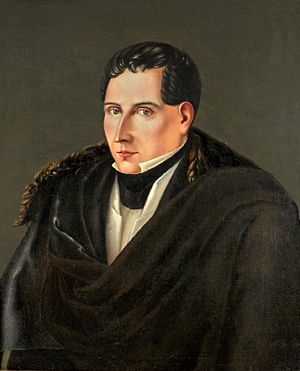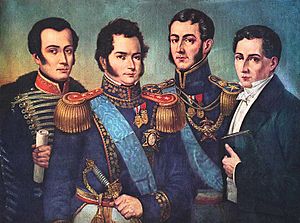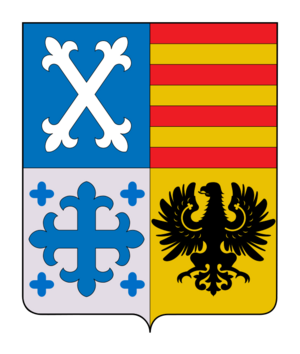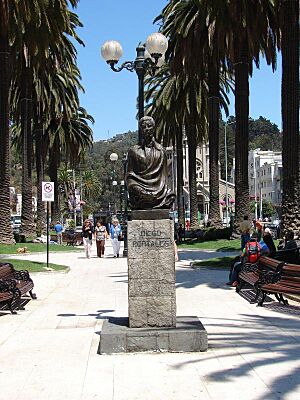Diego Portales facts for kids
Quick facts for kids
Diego Portales
|
|
|---|---|
 |
|
| Minister of the Interior and Foreign Affairs | |
| In office 11 September 1835 – 19 April 1837 |
|
| President | José Joaquín Prieto |
| Preceded by | Joaquín Tocornal Jiménez |
| Succeeded by | Joaquín Tocornal Jiménez |
| In office 6 April 1830 – 1 May 1831 |
|
| Preceded by | Mariano Egaña Fabres |
| Succeeded by | Ramón Errázuriz Aldunate |
| Minister of War | |
| In office 21 September 1835 – 6 June 1837 |
|
| President | José Joaquín Prieto |
| Preceded by | José Javier Bustamante |
| Succeeded by | Ramón de la Cavareda |
| In office 17 January 1831 – 31 August 1832 |
|
| Preceded by | José María de la Cruz Prieto |
| Succeeded by | Ramón de la Cavareda |
| Commander-in-chief of the Chilean Navy | |
| In office 1833–1834 |
|
| Preceded by | José Matías López Orrego |
| Succeeded by | Ramón de la Cavareda |
| Mayor of the province of Valparaíso | |
| In office 1832–1833 |
|
| Preceded by | José María de la Cruz |
| Succeeded by | Ramón de la Cavareda |
| Vice President of Chile | |
| In office 18 September 1831 – 26 May 1833 |
|
| President | José Joaquín Prieto |
| Preceded by | José Tomás Ovalle |
| Succeeded by | Position abolished |
| Deputy of the Republic | |
| In office 29 March 1823 – 3 April 1823 |
|
| Constituency | Santiago |
| Personal details | |
| Born |
Diego José Pedro Víctor Portales y Palazuelos
June 16, 1793 Santiago, Kingdom of Chile |
| Died | June 6, 1837 (aged 43) Valparaíso, Republic of Chile |
| Cause of death | Assassination |
| Resting place | Santiago Metropolitan Cathedral |
| Political party | Conservative |
| Spouse |
Josefa Portales y Larraín
(m. 1819; died 1821) |
| Domestic partner | Constanza de Nordenflycht y Cortés (1823–1837) |
| Profession | Entrepreneur, diplomat, politician |
| Signature |  |
| Military service | |
| Allegiance | |
| Branch/service | |
| Years of service | 1829–1834 |
| Rank | Admiral |
| Battles/wars | Chilean Civil War of 1829 |
Diego José Pedro Víctor Portales y Palazuelos (born June 16, 1793 – died June 6, 1837) was an important Chilean leader and businessman. He served as a powerful minister in President José Joaquín Prieto's government. Portales played a key role in shaping Chile's government and politics in the 1800s. He helped create the Chilean Constitution of 1833, which guided Chile for nearly a century.
Portales believed in a strong central government and conservative ideas. His policies helped make Chile a stable republic. Even though many people didn't like him when he was alive, his murder in 1837 changed public opinion. It helped unite Chileans to support the War of the Confederation. Many people see him as the real power behind the early Chilean republic. He held several important minister positions at the same time, like Minister of War and Minister of the Interior.
Contents
Who was Diego Portales?
Diego Portales was born in Santiago. His father, José Santiago Portales, was in charge of the royal mint. Diego went to school at the Colegio de Santiago. In 1813, he studied law at the National Institute. His family were successful merchants, so Portales also became a merchant.
On August 15, 1819, he married his cousin, Josefa Portales y Larraín. They had two daughters, but both died shortly after birth. His wife also passed away in 1821. Portales never married again. Later, he had three children with Constanza Nordenflicht.
In July 1821, he left his job at the Mint to start his own business. He opened a trading company called Portales, Cea and Co. It was based in Valparaíso with another office in Lima, Peru. His company tried to manage the government's monopoly on tobacco, tea, and liquor. In return, he offered to help pay off Chile's foreign debt. However, Chile was very unstable at the time. The government couldn't control sales, so his company went bankrupt. The government ended up owing Portales money. His political supporters later became known as the estanqueros, which means "monopolists."
Portales' Political Journey
Portales soon joined the conservative side in Chile's political struggles. His business problems pushed him into politics. He quickly became a leading thinker for the conservatives. He helped organize the conservative party.
In 1827, he started a newspaper called El Hambriento (The Starveling). This paper attacked the liberal politicians, known as the pipiolos. Portales was a good writer and used satire in his articles. His writings made him famous and helped him start his political career.
After the conservatives won the Chilean Civil War of 1829, President José Tomás Ovalle y Bezanilla made Portales the Minister of the Interior and Foreign Affairs. He held this important job multiple times under different presidents. He also served as the Minister of War and Navy several times.
Even though Portales was never officially president, he became very powerful. He helped bring order to Chile during a time of chaos. He created a civil militia, which helped end a period of military rule. He supported control by landowners, miners, and merchants. He also made Catholicism the official state religion. Because of his focus on peace and order, businesses in Chile improved.
Portales' Ideas for Government
In 1822, before he became powerful, Portales shared his thoughts on government. He believed that a pure democracy wouldn't work well in countries like Chile. He thought these countries had too many problems and their citizens weren't ready for it. He also didn't think a monarchy was the right answer.
Portales believed Chile needed a strong central government. He thought this government should be led by truly good and patriotic people. These leaders would guide citizens toward order and progress. He felt it was most important to create a stable government, rather than one based on ideas that might not work in real life. He wanted a peaceful but strong government.
The Assassination of Portales
To gain more power, the Chilean government declared martial law. This meant the military had control, and Congress gave the government special powers. In early 1837, a special military court was set up to judge all citizens during the war. People who opposed President José Joaquín Prieto Vial's government accused Portales of being a tyrant. They started a strong newspaper campaign against him and the unpopular war.
The opposition to the war also affected the army. On June 3, 1837, Colonel José Antonio Vidaurre captured Portales. This happened while Portales was inspecting troops in Quillota. Vidaurre then attacked Valparaíso, thinking the public would support him and overthrow the government. However, Rear Admiral Manuel Blanco Encalada defended the city. He defeated Vidaurre's forces near the port in the Battle of Baron.
Captain Santiago Florín, who was guarding Portales, had him shot on June 6, 1837, after hearing about the defeat. Most of the people involved in the plot were later caught and executed.
This murder completely changed how Chileans felt. The government ended martial law, and the country united behind the government. The war became a very important cause, and Portales was seen as a hero who died for his country.
Portales' Lasting Impact

Portales' time in power helped businesses grow and improved the economy. Wealthy people especially benefited from his conservative rule. He also helped Chile stay much more stable than many other countries in Latin America at the time.
He achieved this by improving how the government worked. He had a clear vision for Chile as an independent nation. His influence on the Chilean Constitution of 1833 was very important. This constitution is considered a major achievement for Chile's government in the 1800s. His ideas and principles became the foundation for future Chilean governments. His work was especially important during the years after independence and during the Conservative Republic (1830–1861).
Some historians, like Ramón Sotomayor Valdés and Alberto Edwards, have praised Portales. Other historians, including Benjamín Vicuña Mackenna, Sergio Villalobos, and Gabriel Salazar, have a more critical view of him.
Where are Portales' Remains?
After his assassination, Portales' remains were missing for a long time. In March 2005, they were found in Santiago's Metropolitan Cathedral during renovation work. Forensic tests confirmed they were his. On June 20, 2006, his remains were moved to a special crypt in the Cathedral. A ceremony was held with then-President Michelle Bachelet and other important leaders.
See also
 In Spanish: Diego Portales para niños
In Spanish: Diego Portales para niños
- Chilean Civil War of 1829–1830
Images for kids







